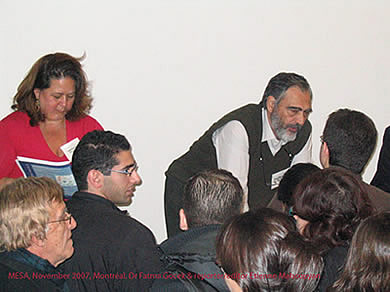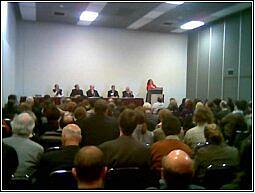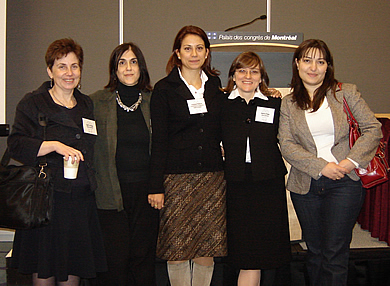- The Society for Armenian Studies (SAS) held its annual meeting in the Palais des Congrès in Montreal in conjunction with the Middle East Studies Association (MESA) November 17-21, 2007 . Now on the threshold of its 35th anniversary, the SAS during the past year organized panels at meetings of MESA in Montreal , the American Historical Association (AHA) in Washington , D.C. , and the Central Eurasian Studies Society (CESS) in Seattle . The SAS participation at the MESA conference, which was attended by more than 1,000 scholars from around the world, was particularly strong, with two panels organized by the Society and several others that SAS members organized or in which they participated.
- Sessions onHrant Dink and Armenians in Canada
- The highlight at the Montreal conference was a panel sponsored jointly by the SAS and the Turkish Studies Association (TSA) dedicated to the memory of slain Armenian journalist Hrant Dink. The session titled On Hrant Dink and Turkish-Armenian Relations was organized by the presidents of the two associations, Professors Richard Hovannisian of UCLA and Andras Riedlmayer of Harvard. The panel attracted an overflow audience of more than 200 academics, including specialists in Turkish and Armenian studies as well as colleagues from other fields. After remarks by both organizers, Dr. Hratch Tchilingirian of Cambridge University spoke on “Hrant Dink before Hrant Dink: Armenians in Turkey .” He was followed by Dr. Fatma Müge Göçek of the University of Michigan , Ann Arbor , who discussed “Hrant Dink and Turkish-Armenian Dialogue.” The third panelist was Professor Levon Zekiyan of Ca’ Foscari University in Venice , who assessed “Hrant Dink’s Innovative Approach to Armenian-Turkish Relations. Its Context, Challenge and Prospects.” The final presentation was by journalist Etyen Mahçupyan, who now edits Hrant Dink’s newspaper Agos, with his reflections on “Agos and the Hrant Dink Foundation: Looking at the Future.” The panel was filled with deep emotion and was received enthusiastically by the large, mixed audience.
- The second SAS-sponsored panel, organized and chaired by Dr. Aida Boudjikanian of the University of Montreal , was on Armenians in Canada: Productions and Transmission of Culture and featured Canadian-Armenian scholars. Dr. Nellie Hogikyan of the University of Montreal assessed the “Armenianness in Atom Egoyan’s Films”; Ph.D. candidate Gabriella Djerrahian of McGill University made “Preliminary Comparisons on a Diasporic Movement: Hip Hop from Here to There”; and Ph.D. candidate Viken Tufenkjian, also of the University of Montreal , presented “A Haze of Petals: The Propagation of Cultural Patrimony by Canadian-Armenian Writers.” Dr. Sima Aprahamian of Concordia University served as the discussant.
- Other Armenian-Related Panels
- An SAS-affiliated panel made up of UCLA graduate students and supported by UCLA was Death and Rebirth: Explorations of Transference in Armenian Literature from Medieval to Modern Times. Organized by Tamar Boyadjian with Myrna Doujian serving as discussant, the panel included Janelle M. Pulczinski who compared “Suicide as a Rite of Passage in Levon Shant’s Ancient Gods and Toni Morrison’s Song of Salomon”; Talar Chahinian on “Narrativizing the Genocide: A Case for Figurative Representation”; and Lilit Keshishyan on “Rewriting the Author: A Look at Aghassi Ayvazyan’s Sayat Nova, Gogol, and Van Gogh.”
- SAS member Victoria Rowe of Chuo University in Japan organized Ottoman Women’s
- Movements and Print Cultures, chaired by Sedef Arat-Ko ç of Ryerson University and with three of the papers focusing on Armenian topics. Sima Aprahamian of Concordia University examined “From Ottomanism to Turkish Nationalism and Beyond: A Brief History of Women’s Movement in Turkey”; Hasmik Khalapyan of the Central European University in Budapest spoke on “The Double Edges of Writing for Ottoman Armenian Women from Late 19th to Early 20th Century”; and Victoria Rowe presented “Gardens of Silihdar and Shirts of Flame: The Writings of Zabel Yesayian and Halide Edib Adivar.” Anastasia Falierouof the French Institute for Anatolian Studies in Istanbul completed the panel with “Moral Modernism and the New Eve: Discourses on Woman in the Greek Orthodox Community (Late 19th and Early 20th Centuries).”
- Other presentations with Armenian content included the following: Hakem Rustom of the London School of Economics, “Reflections on the Turkish-Armenian Migration to France ,” in the panel, Christians of the Middle East: Interrogating Identities from Orientalism to the Diaspora. SAS member Rachel Goshgarian of Harvard University “Blending in and Separating out: Food and Feasts in 16th-Century Anatolian Armenian Texts,” in the panel Starting with Food: Culinary Approaches to Ottoman History. Nefissa Naguib of the Universities of Bergen and Oslo , in a roundtable on Majorities and Minorities in the Middle East and North Africa, considered how Armenian identity is negotiated in Middle Eastern cities such as Cairo or Jerusalem , and the variations within Armenian community members regarding their conception of Armenianness.
- SAS member Carel Bertram of San Francisco State University spoke on “Identity Detours on the Landscapes of Memory: Armenian Pilgrimages to their Anatolian Homes” in a panel she co-organized with Mohammed Salama on The Wild Card of Memory, Challenging the Present: Palestinian and Armenian Historical Consciousness. SAS member Bedross Der Matossian organized the panel Ethnic Politics in the Post-Revolutionary Ottoman Empire (1908-1918). In his paper, “Political Discourse among the Ethnic Groups after the 1908 Revolution,” he analyzed the political discourse among Armenians, Arabs, and Jews after the Young-Turk Revolution of 1908.
- Because visa and other difficulties prevented a number of scholars from traveling to Canada , the panel Turkish-Armenian Relations in the Late Ottoman Empire, organized by Richard Antaramian and Fatma Müge Göçek, of the University of Michigan , had only two of the five members present. The assembled scholars were unable to listen to Antaramian’s “Armenians and the Provincial Administration in the Vilayet of Ankara”; Ani Değirmencioğlu of Vienna University on “Revisiting 1908 and 1909: Reconsidering Historiography by Providing Masses with a Voice”; and Yektan Türkyılmaz on “The Route from Conflict to Catastrophe: The Violent Collapse of Coexistence in Eastern Anatolia : November 1914-April 1915.” Nonetheless, with Dr. Göçek serving as chair and discussant, Professor Hülya Adak of Sabancı University in Istanbul made a penetrating analysis of the apologia of Talat Paşa in his memoirs (Talat Paşa’nın Hatıraları) in her paper “Spacing Nationalism: The Travels of Talat Pasha’s Memoirs.” Dr. Erol Köroğlu of Boğaziçi University spoke on “How to Differentiate between the National Movement and Nationalist Ideologies: A Hrochian Approach to the Late Ottoman Era Turkish Nationalism.” Lerna Ekmekcioğlu of New York University also was unable to be present to speak on “Western Woman the Mediator: Constantinopolitan Armenians and Turks in the 1920s,” in the panel Refugees, Relief Workers, Expatriates, and Locals in Istanbul during and after World War I .
- This report on the participation of SAS and its members at the MESA conference would not be complete without the mention of the Society’s members and Armenian scholars whose participation at the meeting was not related directly to Armenian studies. Thus, Kathryn Babayan of the University of Michigan, Ann Arbor, chaired the panel The Magic of Rituals and Rituals of Magic in the Persianate World, in which she presented “Passing into Manhood in Safavi Craft Circles”; SAS member Nubar Hovsepian of Chapman University in California chaired the panel Living under Occupation, Palestine; SAS member Paul Kaldjian of the University of Wisconsin, Eau Claire, chaired the panel Film and Politics; SAS member Aram Nigogosian participated in the roundtable Internal Dynamics and Transformation in Contemporary Kurdistan; and Lerna Yanik of Bilkent University analyzed “Popular Manifestations of Turkish Nationalism in Turkey’s Best Seller List” in the panel Rethinking Turkish Nationalism: Explaining Continuity and Change in Official and Popular Discourses.
- The SAS Annual Business Meeting
- The annual meeting of the Society for Armenian Studies was held at the Palais des Congrès on November 17. Chaired by President Richard Hovannisian, the meeting was attended by some two dozen members of the Society and three additional members of the executive committee (Bedross Der Matossian, Anahid Aramouni Keshishian, and Hovann Simonian). Professor Hovannisian announced the election of Bedross Der Matossian and Sylva Natalie Manoogian to the executive committee, succeeding outgoing members Robert Krikorian and Vahram Shemmassian. He was pleased to inform the audience that in the past year the number of members of the Society has risen significantly, from 205 to 240, an increase of more than 15 percent. Among other topics discussed at the meeting were organization of SAS panels in 2008 at the conferences of MESA, the Central Eurasian Studies Society (CESS), American Historical Association (AHA) and American Association for the Advancement of Slavic Studies (AAASS); the status of the Avedissian Chair in Armenian Studies at Columbia University; the possibility of holding a separate multidisciplinary Armenian studies conference on the occasion of the 35th anniversary of the SAS; the establishment of an H-Armenian site for the exchange of scholarly information relating to Armenian studies; and the retention of the SAS Secretariat at California State University, Fresno. Professor John Greppin of Cleveland State University announced the release of the sixteenth volumes of the Journal of the Society for Armenian Studies (JSAS). The new editor of the Journal is Professor Joseph Kechichian, and the new editors of the SAS Newsletter are Lilit Keshishyan and Myrna Douzjian of UCLA.
- For further information about the SAS or to obtain past issues of the JSAS, please contact the secretariat at barlowd@csufresno.edu.
|
> Amenology in foreign countries
> The Hrant Dink Panel organized by the Society for Armenian Studies and the Turkish Studies Association in Montreal November 17-21, 2007
Ch.IX.G Dialogues arméno-turc et turco-arménien entre intellectuels et militants pour les droits de l'Homme


